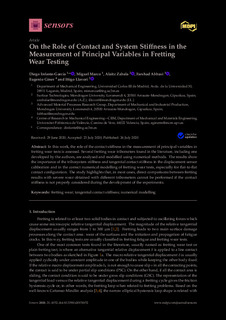| dc.rights.license | Attribution 4.0 International | * |
| dc.contributor.author | Zabala, Alaitz | |
| dc.contributor.author | Abbasi, Farshad | |
| dc.contributor.author | Llavori, Inigo | |
| dc.contributor.other | Infante García, Diego | |
| dc.contributor.other | Marco, Miguel | |
| dc.contributor.other | Giner, Eugenio | |
| dc.date.accessioned | 2020-09-01T11:07:27Z | |
| dc.date.available | 2020-09-01T11:07:27Z | |
| dc.date.issued | 2020 | |
| dc.identifier.issn | 1424-8220 | en |
| dc.identifier.other | https://katalogoa.mondragon.edu/janium-bin/janium_login_opac.pl?find&ficha_no=159473 | en |
| dc.identifier.uri | https://hdl.handle.net/20.500.11984/1806 | |
| dc.description.abstract | In this work, the role of the contact stiffness in the measurement of principal variables in fretting wear tests is assessed. Several fretting wear tribometers found in the literature, including one developed by the authors, are analysed and modelled using numerical methods. The results show the importance of the tribosystem stiffness and tangential contact stiffness in the displacement sensor calibration and in the correct numerical modelling of fretting wear tests, especially for flat-to-flat contact configuration. The study highlights that, in most cases, direct comparisons between fretting results with severe wear obtained with different tribometers cannot be performed if the contact stiffness is not properly considered during the development of the experiments. | es |
| dc.description.sponsorship | Gobierno Vasco | es |
| dc.description.sponsorship | Gobierno de España | es |
| dc.language.iso | eng | en |
| dc.publisher | MDPI AG | en |
| dc.rights | © 2020 by the authors. Licensee MDPI, Basel, Switzerland | en |
| dc.rights.uri | http://creativecommons.org/licenses/by/4.0/ | * |
| dc.subject | fretting wear | en |
| dc.subject | tangential contact stiffness | en |
| dc.subject | numerical modelling | en |
| dc.title | On the Role of Contact and System Stiffness in the Measurement of Principal Variables in Fretting Wear Testing | en |
| dcterms.accessRights | http://purl.org/coar/access_right/c_abf2 | en |
| dcterms.source | Sensors | en |
| local.contributor.group | Tecnologías de superficies | es |
| local.description.peerreviewed | true | en |
| local.identifier.doi | https://doi.org/10.3390/s20154152 | en |
| local.relation.projectID | GV/Elkartek 2017/KK-2017-00053/CAPV/Estudio de los mecanismos de degradación del cable/MEDECA | en |
| local.relation.projectID | GV/Elkartek 2018/KK-2018-00013/CAPV/Estudio de los mecanismos de degradación del cable 2/MEDECA 2 | en |
| local.relation.projectID | GV/Elkartek 2020/KK-2020-00063/CAPV/integración disruptiva de sensórica inteligente en máquinas mediante el empleo de tecnología aditiva/SUSIE | en |
| local.relation.projectID | GE/Programa Estatal de Investigación, Desarrollo e Innovación Orientada a los Retos de la Sociedad, en el marco del Plan Estatal de Investigación Científica y Técnica y de Innovación 2013-2016/DPI2017-89197-C2-1-R/ES/Taladrado de componentes híbridos CFRPS-TI y tolerancia al daño debido a mecanizado durante en comportamiento en servicio de uniones estructurales aeronáuticas | en |
| local.relation.projectID | GE/Programa Estatal de Investigación, Desarrollo e Innovación Orientada a los Retos de la Sociedad, en el marco del Plan Estatal de Investigación Científica y Técnica y de Innovación 2013-2016/DPI2017-89197-C2-2-R/ES/Taladrado de componentes híbridos CFRPS-TI y tolerancia al daño debido a mecanizado durante en comportamiento en servicio de uniones estructurales aeronáuticas | en |
| local.rights.publicationfee | APC | en |
| local.rights.publicationfeeamount | 1852 EUR (2000 CHF) | en |
| local.contributor.otherinstitution | https://ror.org/03ths8210 | es |
| local.contributor.otherinstitution | https://ror.org/01460j859 | es |
| local.source.details | Vol. 20. N. 15. N. artículo 4152, 2020 | en |
| oaire.format.mimetype | application/pdf | |
| oaire.file | $DSPACE\assetstore | |
| oaire.resourceType | http://purl.org/coar/resource_type/c_6501 | en |
| oaire.version | http://purl.org/coar/version/c_970fb48d4fbd8a85 | en |








